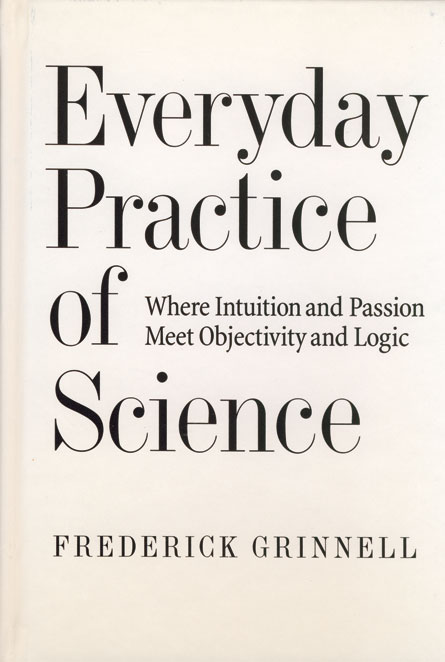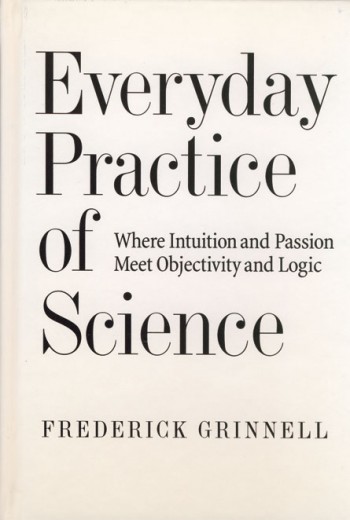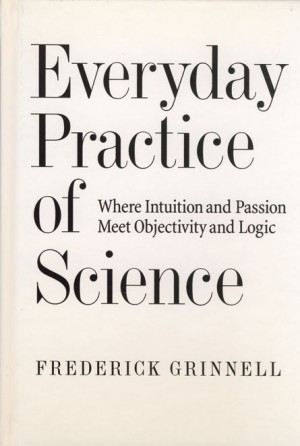Everyday Practice of Science: Where Intuition and Passion Meet Objectivity and Logic
Everyday Practice of Science: Where Intuition and Passion Meet Objectivity and Logic BY FREDERICK GRINNELL OXFORD UNIVERSITY PRESS 248 PAGES Reviewed by Alice Kim From grade school onwards, I was taught that science follows a linear process. The practice of science was equated to the scientific method. During my undergraduate career I had the opportunity […]

Everyday Practice of Science: Where Intuition and Passion Meet Objectivity and Logic
BY FREDERICK GRINNELL
OXFORD UNIVERSITY PRESS
248 PAGES
Reviewed by Alice Kim
From grade school onwards, I was taught that science follows a linear process. The practice of science was equated to the scientific method. During my undergraduate career I had the opportunity to get involved in research through independent research course projects, as well as summer student research programs. Throughout these experiences I started to sense that there may be more to the practice of science than the scientific method that I was taught in school. Now as a graduate student, I’m more aware of the ambiguity and passion that complements the objectivity and logic ingrained in the practice of science. In his book Everyday Practice of Science: Where Intuition and Passion Meet Objectivity and Logic, Dr. Frederick Grinnell describes the practice of science, embracing the role of intuition and passion, as well as logic and objectivity, in the path to discovery. Importantly, throughout his book Grinnell highlights the fact that scientists begin their work with particular interests and commitments. He recognizes that the hegemonic views of society are not filtered out from the practice of science. Instead, he emphasizes that the everyday practice of science seeks truth (small “t”) as we currently understand things, not Truth (capital “T”) that further experience cannot change.
Although the majority of the examples that Grinnell discusses come from the biomedical sciences and the biomedical research community, his examples provide thought-provoking insight into value judgments that are broadly applicable to different disciplines of research. For example, Grinnell discusses issues of trust that are involved in peer review processes of grant applications and research manuscripts submitted for publication, which is relevant to all disciplines of scientific research. Other topics covered in his book include conflict of interest and informed consent.
Grinnell’s discussion on peer review does an excellent job of guiding the reader to think about relevant ethical issues. For example, Grinnell aptly states that although the contents of grant applications and submitted manuscripts are privileged and confidential information, reviewers cannot avoid being affected by what they have learned. The following question that may then arise in the readers mind: How can a reviewer separate themselves and their research from the content of a paper or grant application that is under review? This is an important issue because scientists submit the reports of their studies for review before receiving credit for it, and according to the Society for Neuroscience guidelines for reviewers of manuscripts, the resources that are necessary for research are most often awarded to those with the best ideas and highest productivity. For this reason, it is very important that reviewers do not abuse their advanced access to new ideas, methods, or data. Moreover, since the stakes are so high it is important to consider the ethics of reviewing seriously and carefully. Although Grinnell does not specifically address the question posed above, I recommend Grinnell’s book because it stimulates the reader to think about these sorts of questions.
Moreover, the peer review process is put into perspective through Grinnell’s description and discussion on this topic. For example, writing specifically about grant applications to the National Institute of Health, Grinnell points out that organizing a review panel is a challenging task because the peer reviewers of these applications must be recognized authorities in their fields and must also be funded investigators on projects that are comparable to those under review. This is because peer reviewers should be knowledgeable on the topic of the proposal so that they can assess the applications fairly. A concern that arises then is this: the more closely a reviewer’s expertise overlaps with an applicant’s, the more likely it is that the two could be allies or direct competitors, which then leads to the topic of conflict of interest. This type of guided discussion makes this book a valuable resource for anyone in the early stages of a scientific career, particularly graduate students, and of interest to anyone concerned about science policy and science education.
I thoroughly appreciate the fact that Grinnell does not dodge the topics of scientific misconduct and conflicts of interest, which have raised concerns from the public about the integrity of scientists. In his writing on scientific misconduct, Grinnell highlights the fact that several instances of fabrication and plagiarism were committed by scientists during the late 1970’s, which led to the development of a definition of scientific misconduct in the United States that could accommodate the ambiguity of the practice of science. Although there was much controversy over how misconduct should be defined, Grinnell explains that this was eventually resolved with the government-wide definition that was set forth by the Office of Science and Technology Policy (OSTP). According to the OSTP, scientific misconduct is defined as “fabrication, falsification, or plagiarism in proposing, performing, or reviewing research, or in reporting research results”. This definition also established that “a finding of research misconduct requires that there be a significant departure from accepted practices of the relevant research community” (p118).
Grinnell’s discussion on the development of a Unites States government wide definition of scientific misconduct is interesting, because it highlights the ineffectiveness of guidelines for the conduct of science when vague language, such as the phrase “other practices that seriously deviate”, are utilized. As a graduate student, I’ve started to notice that guidelines for scientific conduct, such as the reviewing of manuscripts and deciding who should be an author on the paper, seem to only provide a general structure of how one should act, since much of the language used in these documents are left to the interpretation of the scientist or scientist in training. Although there may be a set definition of misconduct, often it seems that it is left to the discretion of the individual to assess which acts constitute misconduct in a given situation. Here, it seems that differences in interpretation and opinion lead to conflict, which is undeniably a part of science.
Grinnell’s organization of The Everyday Practice of Science is clear and logical, making the book easy to follow. The book is divided into two general sections. In the first section, Grinnell describes the practice of science with the insight of an insider (one who has been involved in biomedical research for more than 35 years). He takes the time to thoroughly discuss discovery and credibility, which Grinnell considers to be the two activities that are central to the practice of science. Interestingly, he notes that discovery and credibility circle the researcher and that the biography and personality of the researcher influences each step of these processes. In the second section of the book, Grinnell analyzes issues of science and society that have received significant national attention in recent years. He covers the topic of scientific integrity, from the individual level of responsible conduct to the societal level of science policy. He also focuses on issues relevant to informed consent, as well as risks that are present at the interface of human research and genetics. Grinnell then moves on to analyze the relation between science and religion, suggesting that the two represent different attitudes toward human experience that are based on different types of faith.
I highly recommend The Everyday Practice of Science to anyone who is pursuing or even considering a scientific career. Having gone through a North American education system from grade school through to an undergraduate degree in science, I was taught that successful results, organized presentation, and adherence to the structure and rules of the scientific method leads to discovery and reward in science. However, regardless of what one may expect or even wish the practice of science to be, if they stick with it long enough they will discover that it consists of more than the linear scientific method. Grinnell’s book guides the reader through different spheres of the practice of science that are not often, if ever, covered in the classroom or textbooks. Although all graduate students likely already have a basic sense of the everyday practice of science, Grinnell’s discussions illuminate and provoke deeper thought on aspects of practice that one may otherwise not ponder unless/until they are forced to deal with them in their own career. As a last note on the value of taking an interest in the practice of everyday science, I end this review with the Grinnell’s own words from Everyday Practice of Science (p. 20):
Why has everyday practice not become a more central focus for science education? Whatever the reasons, ignoring practice impedes the goals of science education. When he was executive director of the National Science Teachers Association, Bill Aldridge wrote that the framework for science education should be built around three fundamental questions: What do we mean? How do we know? Why do we believe? (31). Those who do not understand the practice of science cannot, in the end, answer these questions.









